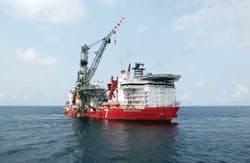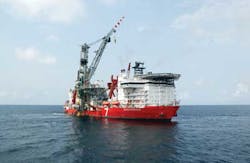P.2 ~ Riser towers deployed for second block 17 deepwater project
View Article as Single page
For both riser towers the bundle comprises:
- One off 24-in. (61-cm) OD core pipe located in the center of the bundle. This is purely structural and acts as the spine of the riser tower
- Four off risers equally distributed around the core pipe: two pipe-in-pipe production risers and two off water injection risers, 12.75-in. (32.4-cm) diameter in the case of the CL riser tower and 10.75-in. (27.3-cm) for the Orquidea/Violeta (OV) riser tower. Maximum liquid flow rates for the production risers range from 43-90,000 b/d, while the maximum flow rate for the water injection risers range from 50-130,000 b/d
- Both production risers comprise an inner pipe (11.14-in. [28.3-cm] OD for OV and 12.97-in. [33-cm] OD for CL) enclosed by an outer pipe (14-in. [35.5-cm] OD for OV and 16.14-in. [41-cm] OD for CL). The inner pipe carries production from the wells while the annulus between the inner and outer pipes is used to inject gas from the FPSO to assist lifting of production through the inner pipe. The gas-lift system is designed to provide 145 bar absolute (bara) at the riser base at 400,000 cu m/d (14 Mcf/d) per production bore, and 80 bara at the riser base at 800,000 cu m/d (30 MMcf/d) per production bore. According to Riser Package Manager Julien Proust, the first pressure figure relates to a flow scenario that arises when production is re-started with the flowlines already filled with "dead" oil. The second pressure figure represents the normal flow case.
Total's insulation requirements for the riser towers were as follows:
- U-value of 3.5 W/sq m/K (although a recent thermal test performed on the production loops showed the insulation performance was in fact better, according to Proust)
- The cool down time is defined as the time before mitigation actions are required after a shutdown to avoid hydrate blockages. The CLOV project riser towers are designed for a cool down time of 13 hr, from 41°C to 22°C (106°F to 72°F), with an ambient temperature of 4°C (39°F)
- Design pressure at mean sea level (O meters), 237 bar (3,437 psi)
- Design temperature: from -10°C to +80°C (14°F to 176°F).
"In the event of an unplanned production shutdown duration exceeding the 13-hr design cooldown time," Proust explained, "the production system (risers and pipelines) is preserved by circulation of dead oil. This circulation operation is performed from the FPSO, thanks to the production loop architecture selected for the development."
Proust noted that "there is no active heating system in the CLOV HRTs," but adds that Subsea 7 is developing electrical heat traced and direct electrical heating for both pipelines and riser systems. "Active heating allows a significant reduction in the length of the flowlines and the number of risers needed on a field, as there is no requirement for a production loop," said Proust. "With active heating, a production line can be preserved during a shutdown by maintaining its temperature above the critical value with regards to hydrates."
CLOV's U-value, design pressure, and design temperature requirements are not particularly stringent in terms of a West Africa deepwater project, Proust notes. "However, the HRT system does facilitate use of more stringent design criteria, such as a lower U-value (e.g. with a dry pipe-in-pipe); a higher design pressure and temperature (with large pipe wall thickness or high-strength steel, and a large range of thermal insulation materials). Both aspects are easily applicable thanks to the fully onshore fabrication of the HRT."
About the Author
Jeremy Beckman
Editor, Europe
Jeremy Beckman has been Editor Europe, Offshore since 1992. Prior to joining Offshore he was a freelance journalist for eight years, working for a variety of electronics, computing and scientific journals in the UK. He regularly writes news columns on trends and events both in the NW Europe offshore region and globally. He also writes features on developments and technology in exploration and production.


